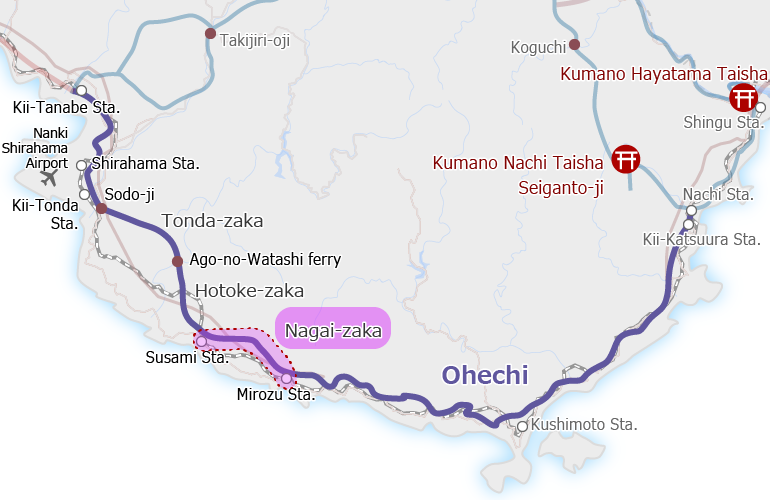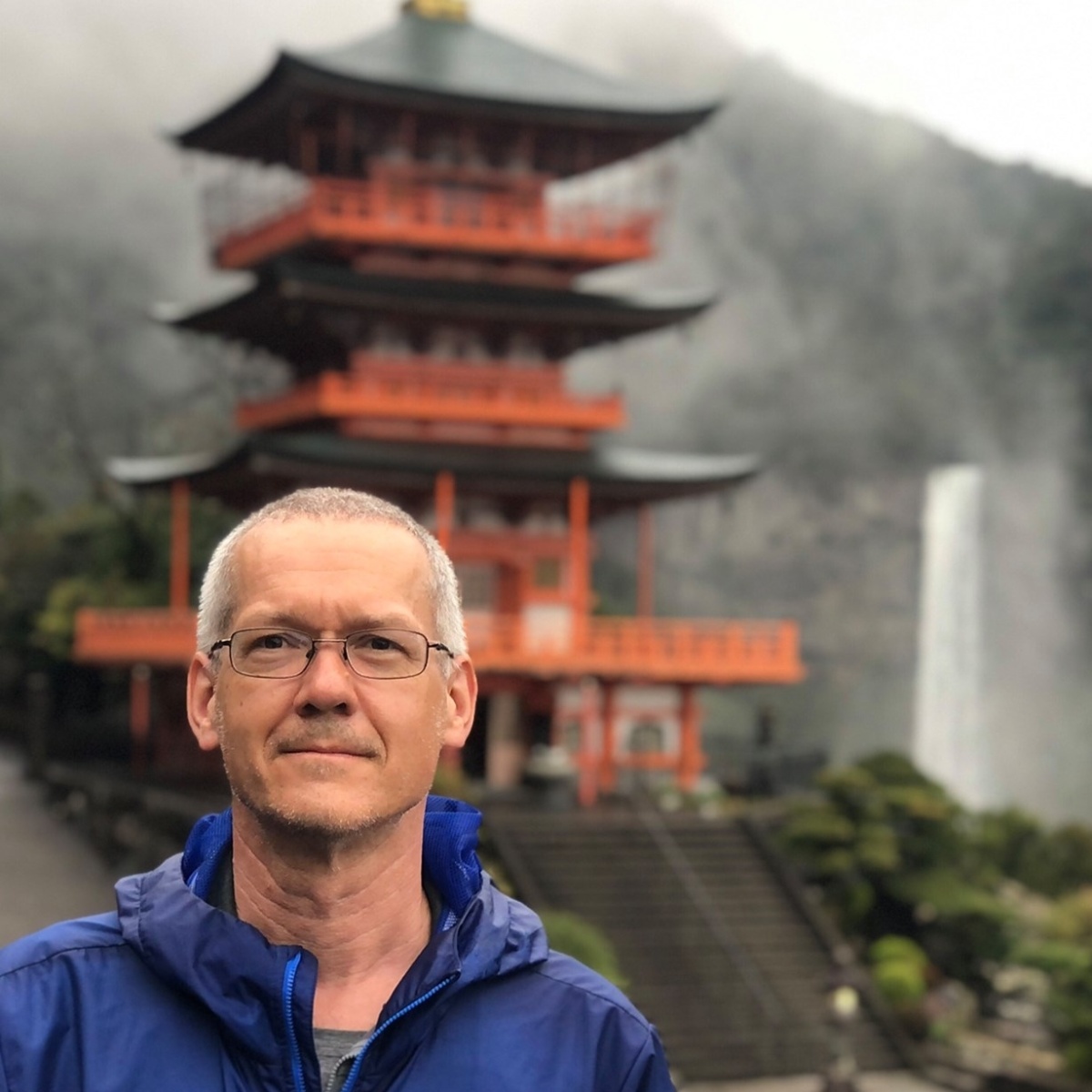Japan’s Stunning Coastal Pilgrimage: The Kumano Kodo's Ohechi Trail
The Ohechi coastal route is an underexplored section of the network of pilgrimage trails that crisscross the Kii Peninsula. John Rucynski shares the highlights of the route after his three-day, two-night journey to the destination of Nachi Taisha shrine.
By John RucynskiHelpful signposts show the way along the Ohechi route.
It is the end of the first day of a three-day hike following the course of an ancient pilgrimage route along the coast of Japan and everything is perfect. Within minutes of checking in at my hotel, I have stripped off my sweat-drenched clothes and I am sitting in solitude, neck deep in a piping hot onsen hot spring, admiring the sun setting over the Pacific Ocean.
The route I am following is one of several pilgrimage trails spread across the Kii Peninsula prefectures of Wakayama, Nara, and Mie, collectively known as the Kumano Kodo (old roads to Kumano). For over one thousand years, the trails have hosted pilgrims who used the rugged terrain for purification on their way to the three grand shrines of Kumano.
My love affair with the trails began about 10 years ago, when I was looking for a more ambitious and adventurous alternative to my frequent day hikes. At the time, hiking was simply a way to combine fitness with my love of nature. But walking the Kumano Kodo has allowed me to trek through cedar and cypress forests on ancient trails, explore centuries-old temples and shrines that provide insights into various periods in Japan’s complex history, and stroll through picturesque villages filled with friendly locals. What I thought might be a one-time visit to the Kumano Kodo has thus turned into a yearly ritual. Although I used to scoff at the concept of “power spots,” I have clearly found mine.
Since the Kumano Kodo received UNESCO designation as part of “Sacred Sites and Pilgrimage Routes in the Kii Mountain Range” in 2004, the Nakahechi route has received the lion’s share of attention from domestic and international travelers. It crosses the peninsula, east to west, and is fairly well developed for visitors. Despite the challenging undulation and long daily distances from village to village, the surging popularity of the route has resulted in the need to book accommodation at least six months in advance during the peak seasons of spring and fall.
For my latest pilgrimage, I focused on the Ohechi route, an underappreciated gem deserving of more attention. The sheer length of this route can make it a bit of a logistical challenge, as it stretches for over 100 kilometers along the Kii Peninsula, connecting the coastal towns of Tanabe and Nachi-Katsuura. It then joins with the Nakahechi route and continues on to culminate at Nachi Taisha, one of the three grand shrines.

The route, from start to finish. The Nagai-zaka section (see Day 2) is highlighted (© Tanabe City Kumano Tourism Bureau).
Several key features set the Ohechi route apart. First, although it does include some steep ascents, the route involves much less elevation gain than the other routes. Second, the Ohechi route offers a refreshing balance of forest and ocean views. Third, whereas the other routes were popularized by pilgrims from the imperial family and nobility, the Ohechi route instead attracted ordinary people and inspiration-seeking artists and writers from around Japan.
In the spirit of nothing ventured, nothing gained, I set out to explore some of the main highlights on a three-day, two-night journey deep into off-the-beaten-path Japan.
Day 1: Into the Forest: Ago-no-watashi Ferry to Susami Station (11 kilometers)
Step back in time with this traditional ferry crossing used to access the Hotoke-zaka.
I’ve crisscrossed Japan by car, bus, train, and even bicycle, but the first day of my pilgrimage kicks off with a new experience, transport across the river by traditional, flat-bottomed wooden boat. The boats are propelled with sweeping strokes of the rudder, and were used for passage across the river from ancient times until the service was discontinued in 1954. Thankfully, the UNESCO designation in 2004 enabled the Ohechi Ago Ferry Preservation Association to revive the service the following year. It is currently the only traditional ferry operating on the Ohechi route. After presenting me with a memorial keepsake, the ferrymen head back across the river.
We start a forest climb soon after alighting from the ferry.
The ferry ride soon feels like a dream as I ascend the steep stone-paved steps of the first saka (“hill” or “slope”) of the pilgrimage, the Hotoke-zaka, and find myself deep in the natural forest. Other than my companions from the ferry passage, I won’t encounter another hiker the entire day. My aging knees are grateful that the maximum elevation for the day is less than 300 meters, making it much easier than a typical day on the Nakahechi or Kohechi routes.
Praying at Susami-oji Shrine, one of numerous subsidiary shrines of the three grand shrines of Kumano. These smaller shrines can be found frequently along the Kumano Kodo routes, as they were used to guide and protect pilgrims.
Although the Kumano Kodo is most famous for linking the three grand shrines of Kumano, there are numerous smaller subsidiary shrines along the way which illustrate the complex religious history of Japan. On the descent to Susami Station I come across Jinoshi Shrine, a rare shrine without an actual building. Instead, the surrounding forest is considered the kami, or deity, a remnant of the animistic beliefs of pre-Shinto days.

Opened in 2021, the Fairfield by Marriott Wakayama Kumano Kodo Susami features immaculate rooms with dynamic views.
The day’s hike finishes at Susami Station, but I make my way to Esumi Station and the nearby Fairfield by Marriott Wakayama Kumano Kodo Susami. After enjoying ocean views during my reviving soak in the hotel’s onsen, I set out to explore the local dining options. What makes this hotel unique is its location just next to a michi no eki (roadside station), which I’m delighted to discover has a quaint restaurant offering local delicacies including fresh seafood, inobuta (a wild boar and pig hybrid) meat, and a selection of Wakayama sake.
Day 2: Along the Coast: Susami Station to Mirozu Station (11 kilometers)
One of many enchanting ocean views along the Nagai-zaka section.
In the morning, I head back to Susami Station for a day of exploring the Nagai-zaka. Many sections of the Ohechi have unfortunately been paved over in the transformation to modern roads, but the Nagai-zaka is still natural. Although the trail undulates throughout the day, there is a total elevation gain of only about 500 meters, and I am frequently rewarded with sudden pristine views of the Karekinada coast and Kuroshima Island.
Wabukagawa-oji Shrine offers a glimpse into Japan’s complex belief system.
An early highlight on this day is Wabukagawa-oji Shrine. Founded in 1625, this subsidiary shrine also houses three sacred Buddhist statues which are believed to pre-date the Muromachi period (1336-1573). The syncretism of Shinto and Buddhism was something unique to Japan, beginning soon after Buddhism was introduced in the sixth century, and saw many important temples and shrines sharing the same grounds. It was a coexistence that lasted until the early years of the Meiji period (1868-1912), when the destruction of Buddhist temples was ordered by the emperor’s new government, and Shinto then became the state religion of Japan.
Walking along the ancient danchiku ridge of the Nagai-zaka.
In two places along the Nagai-zaka trail I find myself on an easy stroll along the ridgeline. Both spots were built using danchiku (plate building), an ancient technique of terraced construction in which soil and clay were pounded together to make level ridgelines that would defend against erosion. The result is a beautiful trail that makes for easy walking and, though man-made, blends in with the natural environment. I imagine ancient pilgrims enjoying this as much as I am in 2024.
A great memento of any Kumano Kodo pilgrimage are the memorial stamps (goshuin) that can be found along the way. The two below are both from the Nagai-zaka section, showing a coastal view and a forest path.
I finish my hike at Mirozu Station, and have chosen Kushimoto for my accommodation destination (about 30 minutes from Mirozu by local train). The southernmost point on the island of Honshu, Kushimoto features some of the most spectacular scenery of the Kii Peninsula in the form of the mysterious hashigui-iwa (“bridge pillar rocks”) that line the coast.
I have a splendid view of the rocks from my room at the Fairfield by Marriott Wakayama Kushimoto. Another advantage of staying here is that the lobby has the Market Place store, which is well-stocked with reasonably-priced local beverages and snacks. You can enjoy your purchases in your room or in the hotel’s spacious and comfortable lobby. As Wakayama Prefecture happens to be the biggest producer of mikan (satsuma mandarin oranges) in Japan, I select Nagisa Beer’s Mikan Ale, and this fruity beer hits the spot on a humid June evening.
This mysterious row of rocky pinnacles known as “bridge pillar rocks” was formed 15 million years ago by the eruption of the Kumano caldera.
Day 3: Into the Mystic: Nachi Station to Nachi Taisha and Falls (8.6 kilometers)
A restored boat at Fudarakusan-ji Temple signifies the journey to the “Pure Land” beyond the ocean taken by monks in search of salvation.
It takes just under an hour to continue the journey from Kushimoto Station to Nachi Station, but a trip to the Kumano Kodo simply isn’t complete without making the pilgrimage to at least one of the three grand shrines of Kumano.
On the way, I make a stop at Hamanomiya-oji (one of the 99 subsidiary Kumano shrines) and Fudarakusan-ji Temple (a branch temple of Seigando-ji Temple in Nachisan). The latter was the launching point for monks who committed themselves to a rare type of solitary self-sacrifice. Between the ninth and eighteenth centuries, some 57 monks and other penitents set sail in small wooden boats that were essentially coffins, with no doors or windows, and only a lantern and 30 days worth of food. Their destination was salvation, represented by the Pure Land of the Kannon (the bodhisattva of compassion and mercy). Most drowned, capsized, or starved, though some were said to have returned to shore. On display at the temple is a restored boat of the type used by the martyrs. The temple also features a stone monument commemorating the monks who made the journey.
Daimon-zaka makes for a majestic final approach to Nachi Taisha and Falls.
Just as I start the ascent to Nachisan, the rainy season finally arrives. I remind myself that the Kumano Kodo is my happy place, and carry on to the final saka of my journey. Although I have regularly walked the steps of the Daimon-zaka over the past 10 years, this approach to Nachi Taisha on cobblestone steps (267 in total) flanked by towering, centuries-old cedar trees still hasn’t lost its charm. I marvel at the Daimon-zaka’s “husband-and-wife trees” (Meoto-sugi), a pair of 800-year-old cedar trees which appear to be holding hands.
Arrival at Nachi Taisha shrine is always a grand culmination of a Kumano Kodo pilgrimage.
The Yatagarasu three-legged crow sitting on the column is an important symbol that can be seen throughout the Kumano region.
Surrounded by primeval forest, Nachi Taisha shrine is part of a huge complex of religious sites further showcasing Japan’s fusion of Shinto and Buddhism. Also evident is the animistic background of Shinto in the form of the 850-year-old sacred camphor tree sanctified as a kami. Another important sight that appears at all of the grand shrines is Yatagarasu. The mythical three-legged crow is worshiped as a god for guiding Emperor Jimmu, the legendary first emperor of Japan, on his journey from Kumano to Yamato (present-day Nara Prefecture).
The three-storied pagoda at Seiganto-ji Temple with Nachi Falls in the background is one of Japan’s most iconic images.
The relentless rain adds to the mystical atmosphere as I make my way down to Nachi Falls, at 133 meters the tallest single-tiered waterfall in Japan. The waterfall itself has long been worshiped as a divine spirit and its power is on full display on this day. I will never tire of ending my pilgrimage by admiring the view of the three-storied pagoda of Seiganto-ji Temple, with the divine waterfall and evergreen primeval forest in the background. But eventually I turn away, and with that, another soul-reviving pilgrimage is complete.
Ohechi Route Access
The gateway to the Ohechi route is JR Kii-Tanabe Station, which can be reached by the Kuroshio limited express train from Osaka in just over two hours. As the train system (JR Kinokuni Line) connecting different sections of the route has a limited schedule, plan accordingly.
Useful Links
Nanki Area Tourism Promotion Committee Ohechi Walking Guide (bilingual)
Tanabe City Kumano Tourism Bureau Course Overview (English)
Tanabe City Kumano Tourism Bureau Virtual Walking Pilgrimage Video (English)
Wakayama Travel Guide Ohechi Route Information (Japanese)
Fairfield by Marriott Wakayama Kumano Kodo Susami
Fairfield by Marriott Wakayama Kushimoto
Photos by Atsushi Ishihara



